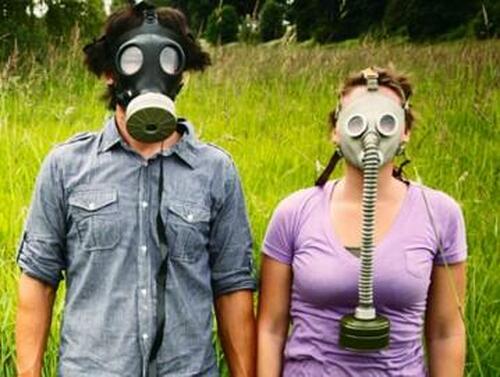
In the days before Covid, doomsday preppers were ridiculed and shunned as part of the fringe minority. Now, they're being celebrated with their own spread in the The Wall Street Journal entitled: "Who Counts as a Disaster Prepper These Days? Lots of Us".
In the article, the Journal points out that there is a "renewed interest in self-reliance" in stocking for emergencies. The article asks whether it has to do with supply chain shortages and empty grocery shelves.
We can't help but ask if it could be people want to front load items before additional 10% annual price hikes? Or if it could possibly have anything to do with the fact that we appear to be on the brink of World War 3? They don't mention in so many words and we...well, we digress.
What the article does note is that increasing sales of ready-made emergency kits and recent surveys suggest that Americans are now more inclined to maintain emergency provisions than they were in the past.
The Journal writes that approximately 33% of the 2,179 U.S. adults polled by financial-services firm Finder in April reported spending an average of $149 over the last year on essentials like non-perishable food, medical supplies, and bottled water. This marks an increase from the roughly 20% who indicated doing so in 2020.
One 39 year man told the Journal: “I’m a PlayStation 5, love-my-comfort guy" and swore he wasn't a prepper. Yet he has 4 bags packed with "snacks, flashlights, water and coloring books for his two young sons" in case of emergency now hanging in his closet.
“It’s taking rational steps to ensure we have the ability to act quickly in those moments,” he added. He cited natural disasters mostly, but also the war in Ukraine as reasons for his prepping: “It’s less that we’re trying to survive the end of the world, and more that we have no idea when an earthquake or tornado is going to happen.”
“People are becoming more and more aware of the problems in the world and how fallible things are,” added John Ramey, founder of self-reliance training site The Prepared. “It’s a totally new market,” added Marlon Smith, who runs a $300 Urban and Outdoor Survival class.
In New York City, Alexjandria Edwards, said she keeps a tent, sleeping bag and water-filtration system in her apartment. She admits it "feels silly" sometimes but wound up purchasing disaster packs off Amazon for about $100 each.
“It’s actually for a family of four, but I was like, ‘You know what? Better to be safe,’” she concluded. She has also been watching videos online about "homeopathic healing and learning to grow her own windowsill vegetable garden" because she worries about food availability.
Good luck with that. You can read the Journal's full report here.
In the days before Covid, doomsday preppers were ridiculed and shunned as part of the fringe minority. Now, they’re being celebrated with their own spread in the The Wall Street Journal entitled: “Who Counts as a Disaster Prepper These Days? Lots of Us”.
In the article, the Journal points out that there is a “renewed interest in self-reliance” in stocking for emergencies. The article asks whether it has to do with supply chain shortages and empty grocery shelves.
We can’t help but ask if it could be people want to front load items before additional 10% annual price hikes? Or if it could possibly have anything to do with the fact that we appear to be on the brink of World War 3? They don’t mention in so many words and we…well, we digress.
What the article does note is that increasing sales of ready-made emergency kits and recent surveys suggest that Americans are now more inclined to maintain emergency provisions than they were in the past.
The Journal writes that approximately 33% of the 2,179 U.S. adults polled by financial-services firm Finder in April reported spending an average of $149 over the last year on essentials like non-perishable food, medical supplies, and bottled water. This marks an increase from the roughly 20% who indicated doing so in 2020.
One 39 year man told the Journal: “I’m a PlayStation 5, love-my-comfort guy” and swore he wasn’t a prepper. Yet he has 4 bags packed with “snacks, flashlights, water and coloring books for his two young sons” in case of emergency now hanging in his closet.
“It’s taking rational steps to ensure we have the ability to act quickly in those moments,” he added. He cited natural disasters mostly, but also the war in Ukraine as reasons for his prepping: “It’s less that we’re trying to survive the end of the world, and more that we have no idea when an earthquake or tornado is going to happen.”
“People are becoming more and more aware of the problems in the world and how fallible things are,” added John Ramey, founder of self-reliance training site The Prepared. “It’s a totally new market,” added Marlon Smith, who runs a $300 Urban and Outdoor Survival class.
In New York City, Alexjandria Edwards, said she keeps a tent, sleeping bag and water-filtration system in her apartment. She admits it “feels silly” sometimes but wound up purchasing disaster packs off Amazon for about $100 each.
“It’s actually for a family of four, but I was like, ‘You know what? Better to be safe,’” she concluded. She has also been watching videos online about “homeopathic healing and learning to grow her own windowsill vegetable garden” because she worries about food availability.
Good luck with that. You can read the Journal’s full report here.
Loading…





